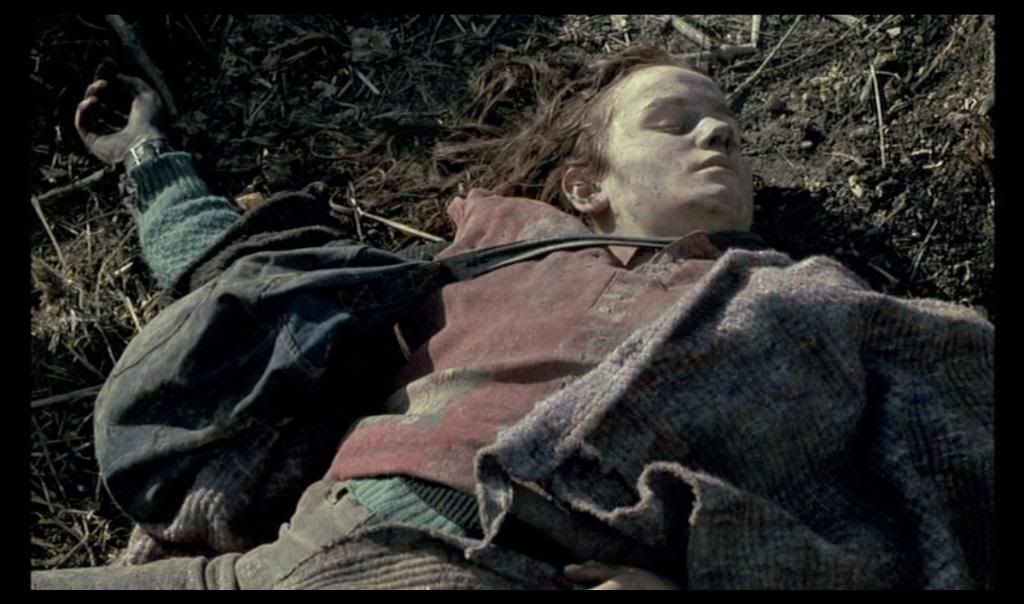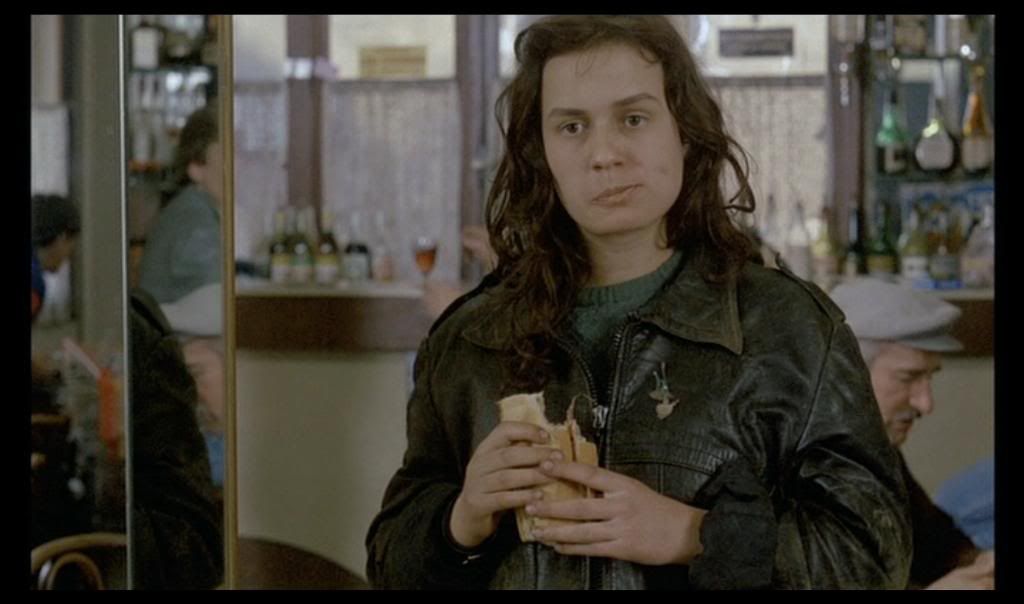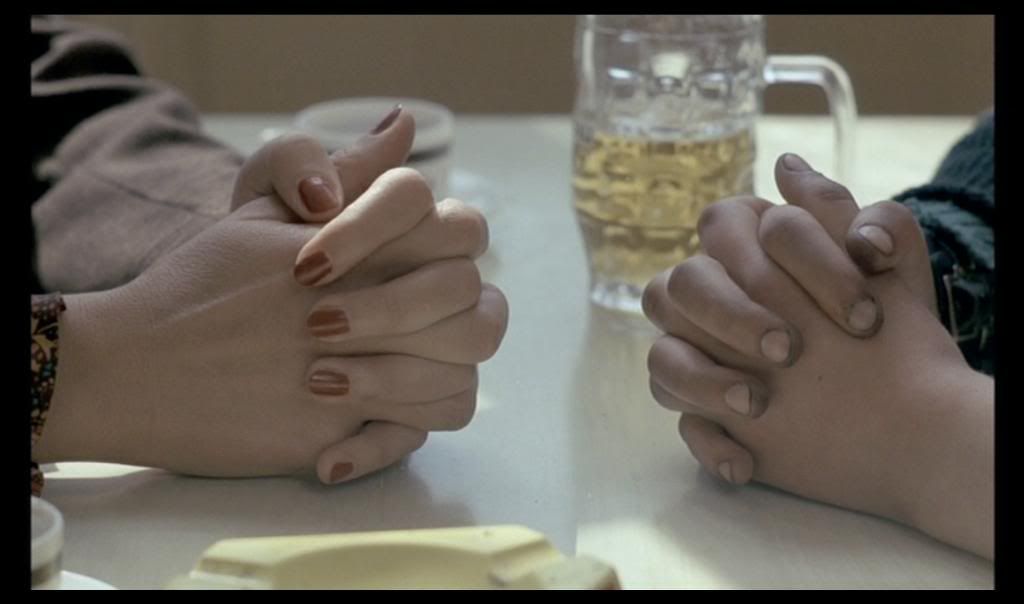By Andrew Chan Despite the persistent belief that great art is driven and justified by an intellectual (rather than emotional or aesthetic) impulse, it is in fact difficult to make a film whose basis is conceptual without the results coming off as simplistic or overly designed. Such films present themselves with the challenge of filtering the world through an idea, a phrase, or even a single word, and ultimately fail if the starting-point diminishes our worldview rather than expanding or complicating it. There are, of course, some outstanding examples of films that wear their thematic concerns on their sleeves while also succeeding as art, one being Kieslowski’s Decalogue, which addressed the limits of its approach by embracing and revising the old form of the parable. Another example would be the major films of Agnès Varda, which employ a mode of storytelling that launches from ideas, or from the rickety language we use to encapsulate ideas, and risks the theoretical and the literary in order to achieve (at its best) a beautifully nuanced metacinema. With the Faulkner-inspired structure of La Pointe Courte, the real-time experiment of Cléo from 5 to 7, and the explorations of one-word concepts (“happiness” and “gleaning”) in Le Bonheur and The Gleaners and I, Varda encourages her audience to question the ways in which movies construct, interrupt, and sometimes collapse the narratives and meanings they put forth.
Despite the persistent belief that great art is driven and justified by an intellectual (rather than emotional or aesthetic) impulse, it is in fact difficult to make a film whose basis is conceptual without the results coming off as simplistic or overly designed. Such films present themselves with the challenge of filtering the world through an idea, a phrase, or even a single word, and ultimately fail if the starting-point diminishes our worldview rather than expanding or complicating it. There are, of course, some outstanding examples of films that wear their thematic concerns on their sleeves while also succeeding as art, one being Kieslowski’s Decalogue, which addressed the limits of its approach by embracing and revising the old form of the parable. Another example would be the major films of Agnès Varda, which employ a mode of storytelling that launches from ideas, or from the rickety language we use to encapsulate ideas, and risks the theoretical and the literary in order to achieve (at its best) a beautifully nuanced metacinema. With the Faulkner-inspired structure of La Pointe Courte, the real-time experiment of Cléo from 5 to 7, and the explorations of one-word concepts (“happiness” and “gleaning”) in Le Bonheur and The Gleaners and I, Varda encourages her audience to question the ways in which movies construct, interrupt, and sometimes collapse the narratives and meanings they put forth.
In 1985’s Vagabond, which won the Golden Lion at the Venice Film Festival and is still probably her masterpiece, Varda’s affinity for the conceptual manifests itself both stylistically and thematically. But her career-long suspicion of any conclusive vérité that might be extracted from cinema makes for a film that revolves around ambiguities and questions rather than big statements; in fact, Varda goes so far as to remind us of this early on with a shot of a red question mark painted on the wall of a building. Like La Pointe Courte and Cléo from 5 to 7, Vagabond operates on a structural gimmick; evoking Citizen Kane, Rashomon, and (according to Varda) the experimental novels of Nathalie Sarraute, the film sets out to reconstruct the life of a dead woman named Mona (Sandrine Bonnaire) through a series of rambling flashbacks punctuated by uniformly terse, direct-to-camera testimonies from people who were acquainted with her. Found frozen to death in a ditch in the opening scene, Mona is revived as a subject for investigation. We learn that she was a drifter but are only given clues to her former life as a typist and vocational school drop-out; we discover nothing of where she used to live or the family she has run away from. As the film moves from scenario to scenario, we meet men who found her sexually unyielding, overly idealistic, or unappreciative of their charity; and women who were fascinated or repulsed by (or even jealous of) her complete disregard for social norms. Highlights among these characters include a hippie who gives Mona shelter; an agronomist who takes her on as a kind of sociological project; a Tunisian migrant worker who promises to take care of her; and a maid who views her as a romantic figure capable of drawing out passion in men. In this tangle of flimsy interpretations, Mona hardens into a new cinematic archetype: a young female rebel who is genuinely without a cause. But neither Varda nor her audience is capable of summoning interpretations that are not ideological or poetic, even though Mona’s journey is strictly non-ideological and non-poetic. We are led back to the devastating old cliché that nothing and no one can be fully known, since knowledge is dependent on competing subjectivities.
Found frozen to death in a ditch in the opening scene, Mona is revived as a subject for investigation. We learn that she was a drifter but are only given clues to her former life as a typist and vocational school drop-out; we discover nothing of where she used to live or the family she has run away from. As the film moves from scenario to scenario, we meet men who found her sexually unyielding, overly idealistic, or unappreciative of their charity; and women who were fascinated or repulsed by (or even jealous of) her complete disregard for social norms. Highlights among these characters include a hippie who gives Mona shelter; an agronomist who takes her on as a kind of sociological project; a Tunisian migrant worker who promises to take care of her; and a maid who views her as a romantic figure capable of drawing out passion in men. In this tangle of flimsy interpretations, Mona hardens into a new cinematic archetype: a young female rebel who is genuinely without a cause. But neither Varda nor her audience is capable of summoning interpretations that are not ideological or poetic, even though Mona’s journey is strictly non-ideological and non-poetic. We are led back to the devastating old cliché that nothing and no one can be fully known, since knowledge is dependent on competing subjectivities.
While the Welles of the ’40s and Kurosawa of the ’50s were a little too pleased with their innovations, directing as if they were the first filmmakers to discover truth’s slipperiness, Varda’s own take on this classic multi-POV structure shows ease and mastery worth those intervening decades. Vagabond begins creakily with Varda as narrator, already mythologizing Mona as some magical creature from the sea; one would be forgiven for anticipating a control-freak of an auteur who won’t stop flaunting her own devices. But the voice-over is dispensed with, and Varda’s grip on the material becomes looser, as if to match the grunginess of her anti-heroine. As she contrasts the overlapping truths emerging from her eccentric cast of characters (most of whom are played by non-professional actors), our attention is directed away from intellectualizing Mona’s splintered identity to experiencing it. Varda’s concept-driven style remains fluid; it rarely overstates itself, and exhibits the director’s willingness to step back and let Bonnaire’s remarkable performance embody not just ideas but also a credible, fascinating, individual self. Despite the faultiness of truth, the film allows for the fact that someone actual is being resurrected here; in a sense, cinema makes real; and the truths about Mona that have been omitted or obscured are no greater than truths omitted and obscured in the constraints of any fiction or non-fiction narrative. In the wild eyes of a precocious actress (Bonnaire was only seventeen at the time of production), Mona’s doom, charisma, and affected dispassion take on a documentary-like authenticity, comparable to legendary direct-from-the-streets performances such as Fernando Ramos de Silva in Pixote. The major theme of Vagabond turns out to be another concept: freedom. (The film would make an interesting double feature with Kieslowski’s upper-class Blue.) The cost of being completely free of society’s expectations, the pain of relationships, and the boredom of work is being, in the end, completely alone. It is clear not only that Mona has liberated herself from the drudgery of what she saw as limited, quotidian options, but also that she is free from making the sacrifices domestic women are forced to make when they marry men. In the ’80s, the phenomenon of “homeless and lawless” women (in the words of the film’s French title, Sans toit ni loi) was still quite new in France. Varda makes a distinction between the reactions Mona receives from the different genders; men, on their motorcycles and in their trucks, often look past Mona’s filth and see a potential sex object, while women see a possibly feminist pioneer who fends for herself in a male world. The film is, on the one hand, repulsed by Mona’s unladylike filth (the camera catches her cleaning out her nose on more than one occasion) and her rejection of all things passionate and interpersonal, but on the other hand, it can’t help but celebrate her almost pious reduction to an elemental existence. This sympathy arises in spite of the fact that Mona never becomes a sympathetic character.
The major theme of Vagabond turns out to be another concept: freedom. (The film would make an interesting double feature with Kieslowski’s upper-class Blue.) The cost of being completely free of society’s expectations, the pain of relationships, and the boredom of work is being, in the end, completely alone. It is clear not only that Mona has liberated herself from the drudgery of what she saw as limited, quotidian options, but also that she is free from making the sacrifices domestic women are forced to make when they marry men. In the ’80s, the phenomenon of “homeless and lawless” women (in the words of the film’s French title, Sans toit ni loi) was still quite new in France. Varda makes a distinction between the reactions Mona receives from the different genders; men, on their motorcycles and in their trucks, often look past Mona’s filth and see a potential sex object, while women see a possibly feminist pioneer who fends for herself in a male world. The film is, on the one hand, repulsed by Mona’s unladylike filth (the camera catches her cleaning out her nose on more than one occasion) and her rejection of all things passionate and interpersonal, but on the other hand, it can’t help but celebrate her almost pious reduction to an elemental existence. This sympathy arises in spite of the fact that Mona never becomes a sympathetic character.
Even more urgent than the film’s ideas on freedom is this question of sympathy, which is a sly but forceful implication of the audience. The film implicitly asks: What qualities are required for a person to be deserving of other people’s compassion? The same question was hurled last year at the Thoreau-wannabe in Into the Wild, another willfully irresponsible outcast who, one might argue, also brought tragedy on himself. But Vagabond is much less romantic and transcendent than that film, or almost any other film about drifters that has followed it. With dirt-colored cinematography, prickly textures, and an eerie violin score that mimics a lacerating wind, it rarely gives us refuge from the harshness of its exteriors; it seems that few films have ever been set at such a merciless physical and emotional temperature. When we first see Mona’s dead body in this dead landscape, our impulse is to search for the victim, the martyr, or the symbol in her. But we can’t pity her the way we do Lars von Trier’s put-upon stoics; we learn soon enough that she’s an unapologetic nihilist who has no interest in saving herself, let alone the world. What place does our compassion and charity take in this story? How do we explain her motivations to ourselves? Is she responsible for the choices she makes in a world that seems to be without real choices? Can we dismiss her as the product of social oppression or psychological illness, or do we find pieces of our most fundamental fears and longings in her? These questions go to the heart of how poverty, pain, and filth continue to be moralized in our society. Vagabond, one of Varda’s most shrewdly political films, recognizes the privileged position cinema places us in by offering entire lives up to our scrutiny. It makes itself equal to such a responsibility. The film’s great achievement is a character who repeatedly confounds our most ingrained senses of judgment.
But we can’t pity her the way we do Lars von Trier’s put-upon stoics; we learn soon enough that she’s an unapologetic nihilist who has no interest in saving herself, let alone the world. What place does our compassion and charity take in this story? How do we explain her motivations to ourselves? Is she responsible for the choices she makes in a world that seems to be without real choices? Can we dismiss her as the product of social oppression or psychological illness, or do we find pieces of our most fundamental fears and longings in her? These questions go to the heart of how poverty, pain, and filth continue to be moralized in our society. Vagabond, one of Varda’s most shrewdly political films, recognizes the privileged position cinema places us in by offering entire lives up to our scrutiny. It makes itself equal to such a responsibility. The film’s great achievement is a character who repeatedly confounds our most ingrained senses of judgment.
Image/Sound/Extras: The fourth disc in The Criterion Collection’s generous and eye-opening set 4 by Agnès Varda, this is an update of an extra-less version the company released in 2000. Image and sound are as immaculate as one would expect from a new high-definition digital transfer supervised by the director herself. The illuminating essay included with the package, written by critic Chris Darke, is a vast improvement on the one by Sandy Flitterman-Lewis found in the earlier edition. But the real highlights here are a new bounty of supplements: these include the forty-minute making-of documentary Remembrances, in which we get to see an older, shockingly glamorous Sandrine Bonnaire; a brief interview with composer Joanna Bruzdowicz followed by a back-to-back presentation of all the film’s dolly shots; a 1986 radio interview that explains why Varda dedicated the film to the French novelist Nathalie Sarraute and which suggests a kinship between these two underappreciated, groundbreaking female artists; and, perhaps best of all, a short tribute, in much-degraded 16mm, to the charming actress Marthe Jarnais.
Andrew Chan is a poet and film critic currently studying at UNC-Chapel Hill. He is the creator of the blog Movie Love.
Monday, January 1, 2007
The Criterion Collection #74: Vagabond
Labels:
Agnès Varda,
Andrew Chan,
Vagabond
Subscribe to:
Post Comments (Atom)
No comments:
Post a Comment